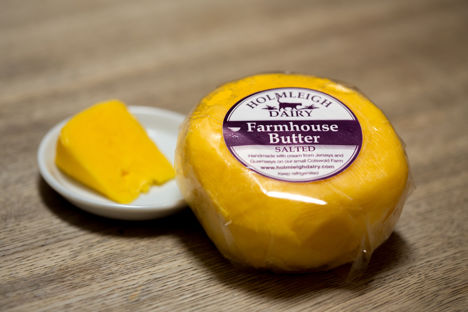
Supply chain: The Kingham Plough and Holmleigh Dairy
Tom Shingler visits Emily Watkins in her acclaimed country pub and restaurant The Kingham Plough to see why she's such a fan of her local dairy producer.
Supply chain: The Kingham Plough and Holmleigh Dairy
Tom Shingler visits Emily Watkins in her acclaimed country pub and restaurant The Kingham Plough to see why she's such a fan of her local dairy producer.
‘Local produce’ is a term bandied around so much these days that it’s started to lose meaning. All too often it’s followed by ‘where possible’, which gives no clue as to how much actually does come from nearby, and the definition of the word ‘local’ is pretty vague – for some it can mean down the road, for others within the surrounding counties. However, one chef that’s always championed provenance as one of the most important aspects of a menu is Emily Watkins, chef-proprietor of The Kingham Plough in Oxfordshire.
Being based in the Cotswolds countryside means there are plenty of farmers nearby to supply Emily’s kitchen with what they need. But the one she seems particularly passionate about is Holmleigh Dairy, a small family-owned business that sells Jersey and Geurnsey milk and butter to the local area.
‘I first found out about Holmleigh by accident – the way you usually find out about good suppliers,’ she says. ‘For the past nine years, we’ve run a farmers’ market in the Plough’s car park to bring our customers and producers together. We were one of the first to namecheck our suppliers on our menus, and I don’t think people really believed they were real! A cheesemaker called Roger Crudge who lives opposite the pub always had a stall there, and he introduced me to Holmleigh’s butter. I was so taken with it that I started working with them the day after.’
Holmleigh is based in the village of Donnington, around nine miles from The Kingham Plough. Its main business comes from old fashioned door-to-door milk delivery, but the hand-churned butter was a huge hit the second it went on the menu. ‘People are always asking about it,’ says Emily. ‘It’s a deep, deep yellow colour full of proper salt crystals and almost like cheese because it’s so rich and creamy.’
Emily serves the butter with bread at the beginning of a meal and uses it in dishes like her coronation chicken terrine, which comes with a pat of curried butter. But it’s Holmleigh’s milk that gets used the most in her cooking.
‘I live on a dairy farm and used to get my milk and cream from there, but sadly the company (Nell’s Dairy) closed down. The obvious decision was to just go to Holmleigh for all our milk needs as they’re such lovely people and have such a great product. They do everything from getting the cows in the morning to milking them, pasteurising the milk and delivering it themselves.
‘We use the milk or cream every day as we make our own ice cream on-site,’ adds Emily. ‘I also use it in desserts as a standalone ingredient, because it’s such good quality. For example, we’ve got a milk and borage honey jelly which has just gone on the menu, served with homemade honeycomb, blackberry granita, fresh blackberries, blackberry syrup and wood sorrel. It’s a really nice September dish that has Holmleigh milk at the heart of it.’
When we think of good produce, it’s usually fresh seafood, well-hung beef or heritage vegetables that come to mind. The fact that Emily is championing milk – often seen as little more than a commodity – speaks volumes about its quality. ‘The milk is sweeter and more full-bodied than standard stuff,’ she says. ‘It’s like the difference between using water and stock, or drinking rubbish wine that tastes a bit naked. The flavour is really impressive – it’s almost as if you’ve left crunchy nut cornflakes soaking in the milk overnight because it has this lovely malty taste.’
Of course, you can have access to the best produce in the world, but if your supplier isn’t reliable then it poses serious problems in the kitchen. Luckily for Emily, however, Julian and Susan Garbett – the owners of Holmleigh – are always on time with their deliveries and know how important consistency is. ‘The deliveries always turn up when you want them,’ she says. ‘They’ve had the business since the 1970s so they know what they’re doing. Julian is a proper picture perfect West Country dairy farmer, always wearing his hat and driving his landrover, and the prices are always consistent and fair.’
But are there any downsides to working with such a small, hyper-local producer? Bigger dairies homogenise and standardise their milk so it’s exactly the same throughout the year, but Emily says this sacrifices flavour for consistency. ‘When the winter comes and the cows are fed silage instead of grass, there’s a noticeable difference in the amount of fat in the milk,’ she explains, ‘and it changes again in the spring. This means you have to learn to work with the product – the same ice cream recipe you’ve been using for weeks starts to come out too buttery because the fat content in the milk has changed, so you have to adapt. But it’s definitely worth it – because Holmleigh’s milk is from their own herd of Jersey and Geurnsey cows, isn’t homogenised and everything is done on-site, it’s some of the best milk money can buy.’


